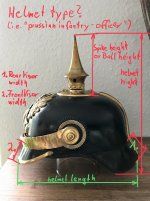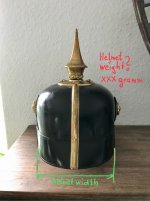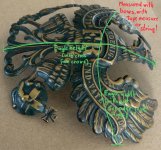Sandmann
Well-known member
Dear friends,
as you may know, I like to explore the history and evolution of the Pickelhaube. However, I started a new project with the support of Amy, Tony and John M and would like to ask more of you fellow collectors for support now. I would therefore be happy if anyone who wants to take part and has the time could take a few measurements (as shown in the attached pics) from as many helmets as you want and send them to me. I will then collect these helmet datas in a table, which I will make available to everyone who is interested in it, afterward. The more different helmets we measure and collect, the better the database gets.
With this collection of data, I would like to determine the average dimensions of each pickelhaube model and some of their components and thus determine the probably specified dimensions of the various models and the circulation of issued helmets. Unfortunately, dimensions were not specified in the clothing regulations before 1895. In the earlier clothing regulations this was probably done using an enclosed drawing that I did not know. It is also interesting for me how dimensionally stable the helmets were, especially the M95 and M15 helmets, since the helmet height of 21 cm to 21.3 cm was extremely tight tolerated.
I hope many of you will take part, because I only own 3 M95 officer's helmets myself and I need your help.
Thank you very much in advance for your support.
Best wishes,
Sandy



as you may know, I like to explore the history and evolution of the Pickelhaube. However, I started a new project with the support of Amy, Tony and John M and would like to ask more of you fellow collectors for support now. I would therefore be happy if anyone who wants to take part and has the time could take a few measurements (as shown in the attached pics) from as many helmets as you want and send them to me. I will then collect these helmet datas in a table, which I will make available to everyone who is interested in it, afterward. The more different helmets we measure and collect, the better the database gets.
With this collection of data, I would like to determine the average dimensions of each pickelhaube model and some of their components and thus determine the probably specified dimensions of the various models and the circulation of issued helmets. Unfortunately, dimensions were not specified in the clothing regulations before 1895. In the earlier clothing regulations this was probably done using an enclosed drawing that I did not know. It is also interesting for me how dimensionally stable the helmets were, especially the M95 and M15 helmets, since the helmet height of 21 cm to 21.3 cm was extremely tight tolerated.
I hope many of you will take part, because I only own 3 M95 officer's helmets myself and I need your help.
Thank you very much in advance for your support.
Best wishes,
Sandy



